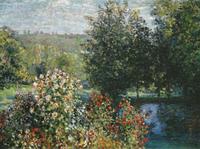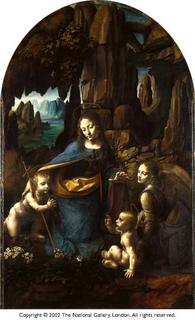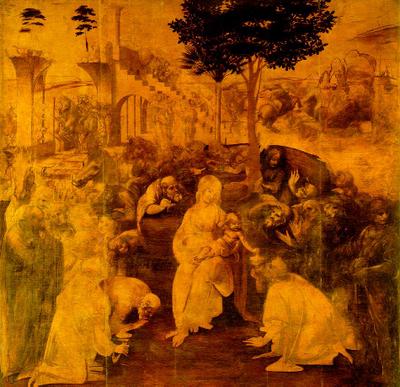A Night Sky I will Never Forget!
 The Starry Night. Saint Rémy, June 1889
The Starry Night. Saint Rémy, June 1889This is an exploration of some of the world's greatest paintings.
 The Starry Night. Saint Rémy, June 1889
The Starry Night. Saint Rémy, June 1889

 Nymphéas, 1907
Nymphéas, 1907 Route à Louveciennes, effet de neige, 1869-1870
Route à Louveciennes, effet de neige, 1869-1870 Les rosiers dans le jardin de Montgeron, 1876
Les rosiers dans le jardin de Montgeron, 1876  I just came across this news which I dont know how I missed earlier. In July 2005, London's National Gallery's team of experts used infrared reflectography to find two distinct underdrawings beneath the surface of Leonardo da Vinci's 'Virgin of the Rocks'. Though one drawing corresponds with the final version of the painting, another shows a completely different picture of a kneeling figure. Her downcast gaze and pious gestures suggest that Leonardo's initial idea was to depict the Virgin in Adoration of the Christ Child. There is no sign of the baby Jesus, but this could be because Leonardo abandoned this idea before he came to include him.
I just came across this news which I dont know how I missed earlier. In July 2005, London's National Gallery's team of experts used infrared reflectography to find two distinct underdrawings beneath the surface of Leonardo da Vinci's 'Virgin of the Rocks'. Though one drawing corresponds with the final version of the painting, another shows a completely different picture of a kneeling figure. Her downcast gaze and pious gestures suggest that Leonardo's initial idea was to depict the Virgin in Adoration of the Christ Child. There is no sign of the baby Jesus, but this could be because Leonardo abandoned this idea before he came to include him.
The Virgin of the Rocks, 1491-1508
LEONARDO da Vinci, 1452 - 1519
National Gallery, London
aa
_____________
________aaaaaa
Virgin of the Rocks, 1483-86
LEONARDO da Vinci, 1452 - 1519
Musée du Louvre, Paris
 Sunflowers, 1889
Sunflowers, 1889 Sunflowers, 1888
Sunflowers, 1888 Vase with Twelve Sunflowers, 1888
Vase with Twelve Sunflowers, 1888 Madame Henriot
Madame Henriot If you have read and loved Da Vinci Code, the best selling novel that has spawned a whole cottage industry of museum tours and books, this piece of news will intrigue you. Maurizio Seracini, an associate professor at the University of Cagliari, and head of Editech, a conservation company in Florence has been able to prove that the top layer of the Adoration of the Magi is not by Leonardo. Chemical analysis and microscopic examination has shown that the painting's surface layer in the painted areas dates from the period between 1530 and 1580, i.e. between fifty and a hundred years after Leonardo abandoned the work.
If you have read and loved Da Vinci Code, the best selling novel that has spawned a whole cottage industry of museum tours and books, this piece of news will intrigue you. Maurizio Seracini, an associate professor at the University of Cagliari, and head of Editech, a conservation company in Florence has been able to prove that the top layer of the Adoration of the Magi is not by Leonardo. Chemical analysis and microscopic examination has shown that the painting's surface layer in the painted areas dates from the period between 1530 and 1580, i.e. between fifty and a hundred years after Leonardo abandoned the work.Mr Seracini has examined the painting minutely using a technique that exploits the fact infra-red light passes through paint but reflects off the under-drawing. He and his team have conjured from below the amber-brown layer with which much of the panel is covered a collection of Da Vinci's drawings that were hidden for more than five centuries. They contain numerous previously invisible - or barely discernible - details. "You get a wonderful sense of Leonardo's creative ferment," said Martin Kemp, an art history professor at Oxford University and one of the few experts who has seen the partial results of Mr Seracini's work. "The amount of brainstorming going on underneath the painting is remarkable."
In an exclusive interview to Guardian, Mrs Seracini revealed details on whats in the under-drawing. Some will electrify conspiracy theorists.
Why did Leonard not complete The Adoration of the Magi ? Why did he make the underpainting using a mixture of lampblack and watery glue and then seal it with lead white? Did he suspect that his work would not stay the way he intended it, and may have deliberately preserved it that way? Is there a hidden messge in the scene? These are questions that will plague scholars the world over.
 The 39-in by 32-in canvas is widely regarded as one of the most stunning depictions of adolescent beauty became the most expensive painting ever sold when it was bought by an anonymous bidder $104 million at The Sotheby's New York in 2004.
The 39-in by 32-in canvas is widely regarded as one of the most stunning depictions of adolescent beauty became the most expensive painting ever sold when it was bought by an anonymous bidder $104 million at The Sotheby's New York in 2004.